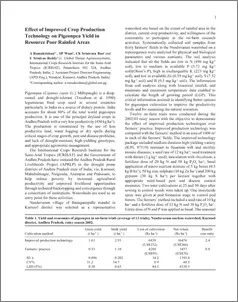Effect of improved crop production technology on pigeonpea yield in resource poor rainfed areas

Abstract
Twelve on-farm trials were conducted in Nandavaram village of Banaganapalle mandal in Kurnool district, Andhra Pradesh, India, during the 2002/03 rainy season to study the effects of improved production technologies (T1) and farmers' practice (T2) on pigeon pea yield. T1 consisted of a medium-duration high-yielding cultivar (ICPL 87119), sowing rate of 12 kg/ha, seed treatment with thiram (3 g/kg), inoculation with Rhizobium, 20 kg N, 50 kg P2O5/ha, basal application of micronutrient mixture (5 kg borax, 0.5 kg B/ha; 50 kg zinc sulfate, 10 kg Zn/ha; and 200 kg gypsum, 30 kg S/ha), and need-based pest and disease control measures. Inter-cultivation was conducted at 25 and 50 days after sowing to control weeds. One insecticide spray was given at the pod formation stage to control pod borers. T2 included a sowing rate of 10 kg/ha, 12 kg N/ha, and 30 kg P2O5/ha. T1 gave higher yields than T2 and recorded a mean grain yield of 1.61 t/ha, which was 204% higher than that obtained with T2 (0.53 t/ha). T1 also resulted in higher stalk yield (2.93 t/ha) than T2 (1.10 t/ha). The increased grain and stalk yields under were mainly because of increased total dry matter, pod weight, shelling percentage, 100-grain weight and harvest index. T1 recorded a higher mean income (US$290) and a cost-benefit ratio of 2.4
